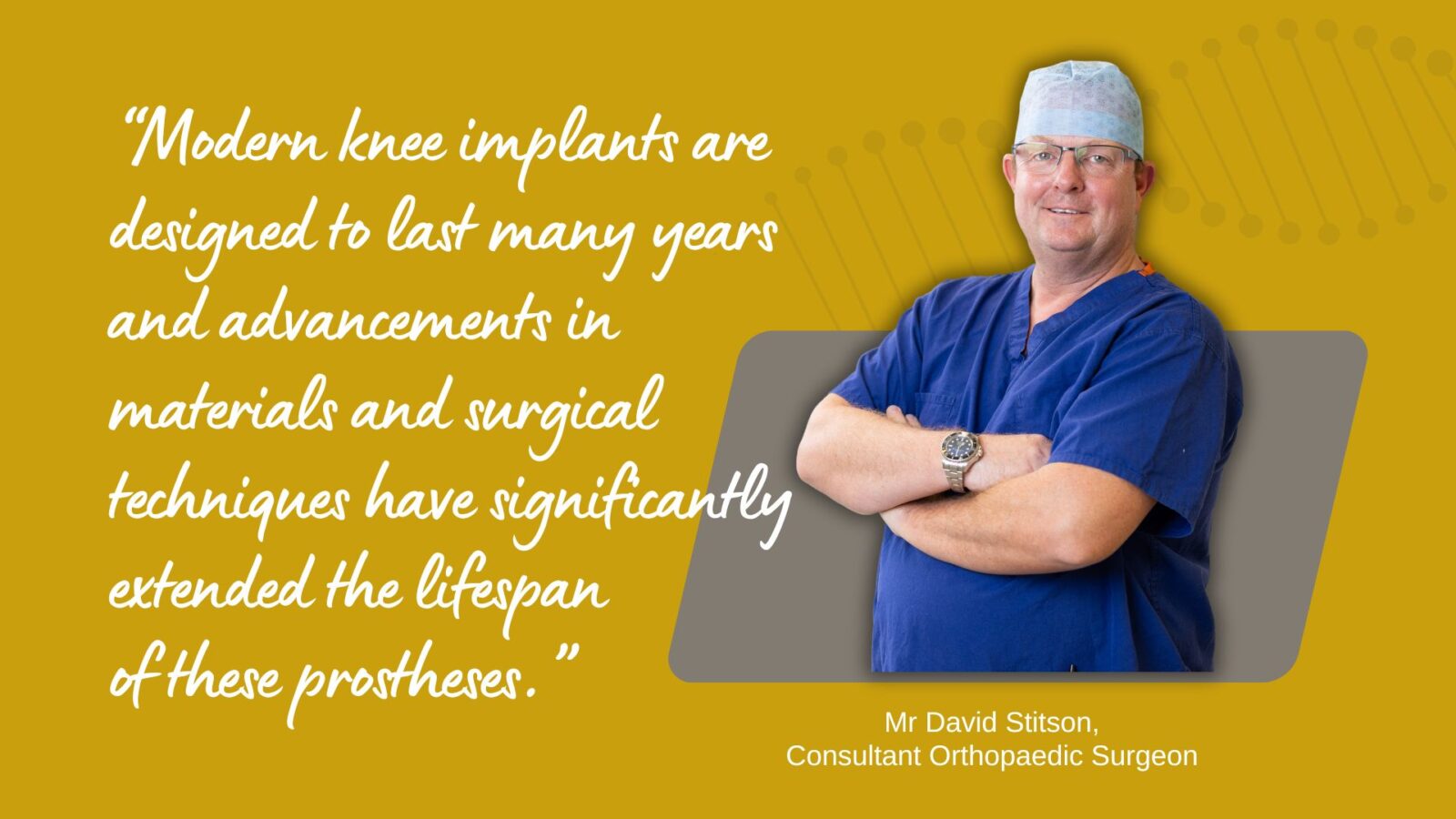Undergoing a knee replacement is a significant medical intervention that can dramatically improve quality of life by relieving pain and restoring function.
However, returning to a physically active lifestyle after such a procedure requires careful planning and patience. It is important to understand which sports are safe to take part in post-surgery and how to reintroduce physical activity gradually and safely.
Contents
ToggleThis process involves adhering to a knee rehabilitation programme and recognising the body’s cues to ensure a successful and sustainable recovery.
What is Knee Replacement Surgery?
Knee replacement surgery, (medically known as knee arthroplasty), is a procedure aimed at replacing the weight-bearing surfaces of the knee joint to alleviate pain and disability. It is typically carried out for patients experiencing severe pain and diminished quality of life due to osteoarthritis, or similar joint issues.
In this surgical procedure the damaged parts of the knee are replaced with artificial parts, usually composed of metal and plastic. These prosthetics are designed to mimic the function of a natural knee, allowing better movement with reducing discomfort.
The primary goal of knee replacement surgery is to improve joint mobility, thus enabling individuals to resume their daily activities with reduced pain. It stands as a highly successful operation, providing relief and enhancing physical function for millions worldwide.
Common Reasons for Knee Replacement
There are several reasons why an individual might undergo knee replacement surgery. Some of the most common include:
– Severe Osteoarthritis: This degenerative joint disease wears away cartilage, leading to pain and stiffness.
– Rheumatoid Arthritis: An autoimmune disorder causing inflammation and destruction of joint tissue.
– Post-Traumatic Arthritis: This arises from serious knee injuries that cause joint damage over time.
– Deformities: Conditions such as knee bowing or knock-knees that affect posture and walking.
– Failed Previous Surgeries: Earlier surgical attempts to repair knee damage might not always succeed, necessitating knee replacement surgery.
These conditions can significantly affect a person’s ability to engage in various sports and physical activities, making a knee replacement a viable option for restoring an active lifestyle.
Expected Recovery Timeline
The recovery timeline post-knee replacement surgery is crucial as it helps set realistic expectations and goals. Initial hospital stay for knee replacement may last a day or two, allowing healthcare professionals to monitor progress. The first few weeks post-surgery are integral for physical therapy and rehabilitation.
– 0 to 6 weeks: This is the initial recovery phase where pain and swelling are common. Most patients can start walking with an assistive device and begin basic physiotherapy exercises.
– 6 to 12 weeks: By this period, most patients can walk more comfortably and are encouraged to continue physiotherapy. The aim is to gradually increase mobility and strength.
– 3 to 6 months: A more extensive range of movements becomes possible. Regular activities can often be resumed, including walking longer distances and engaging in low-impact sports.
– 6 months to a year: By the end of a year, patients typically regain the full strength and function of their knee, though improvement can still be seen beyond this period.
Recovery timelines can vary based on individual health, the pre-operative condition of the knee, rehabilitation adherence and the presence of any complications. It is crucial to follow medical advice for optimal recovery.
Postoperative Care and Initial Recovery for a Knee Replacement
Importance of Rehabilitation
Knee rehabilitation is the cornerstone of successful knee replacement recovery. It involves a structured program designed to restore strength and mobility in the knee and surrounding muscles. Rehabilitation commences shortly after surgery, pivoting from hospital-based therapy to ongoing outpatient sessions.
The significance of rehabilitation cannot be overstated as it directly impacts the recovery outcome. It aids in increasing knee flexibility, reducing swelling and strengthening muscles, all of which are vital for supporting the knee joint. Regular physiotherapy sessions also help prevent stiffness and ensure that patients regain the highest level of function possible, allowing a return to daily activities and, eventually, to certain sports pursuits.
Physiotherapy and Exercises
Physiotherapy plays a pivotal role in the knee rehabilitation process. Patients are often introduced to physiotherapy soon after surgery to begin motion and function rehabilitation. Initially, exercises focus on improving circulation, reducing stiffness, and strengthening the quadriceps.
Common knee strengthening exercises include:
– Ankle Pumps: Helps maintain blood circulation in the lower limbs.
– Quadriceps Sets: Strengthens thigh muscles.
– Straight Leg Raises: Builds strength without bending the knee.
– Heel Slides: Encourages knee flexion and extension.
– Stationary Biking: Introduced later, it aids in mobility and low-impact strengthening.
The exercises are advanced incrementally with guidance from a physiotherapist. Commitment to a structured exercise regimen is essential for regaining full functionality and transitioning back to sports with minimal risk of injury.
Diet and Lifestyle Adjustments
Beyond exercises, diet and lifestyle adjustments support the healing process and contribute to a successful recovery following knee replacement surgery. Nutrition plays an integral role in tissue repair and overall health. A balanced diet rich in proteins, vitamins, and minerals supports healing:
– Protein: Essential for repairing tissues and muscles.
– Calcium and Vitamin D: Crucial for bone health.
– Omega-3 Fatty Acids: Found in fish, these support reduced inflammation.
Maintaining a healthy weight is also necessary, as excess weight can add stress to the newly replaced joint. Patients should therefore aim for a balanced diet while incorporating regular, low-impact activities to manage weight effectively.
In addition to dietary considerations, lifestyle adjustments are crucial. Smokers should consider cessation programs, as smoking can impede healing. Moreover, adhering to medical advice on rest, hydration, and incremental physical activity can significantly bolster recovery efforts.
Through careful attention to rehabilitative practices, physiotherapy exercises, and dietary habits, individuals can look forward to successfully resuming their active lifestyles post knee replacement surgery.
Transitioning Back to Sports After a Knee Replacement
Returning to sports after a knee replacement is something many individuals strive for to maintain their active lifestyle. Understanding the types of activities you can engage in is crucial to a successful recovery.
Here is an informative guide to help you transition back to sports safely after your knee replacement surgery.
Low-Impact Activities
Initially, it is essential to start with low-impact activities. These exercises are gentle on the new knee joint and can help build strength and flexibility without causing undue stress or injury.
– Walking: Begin with short distances on flat surfaces. This is a great way to increase mobility and improve cardiovascular health.
READ: 3 Essential Tips For Walking Normally After Knee Surgery
– Swimming: Providing excellent resistance with minimal strain on the joints, swimming can enhance muscle tone and endurance.
– Cycling: Stationary cycling, in particular, is beneficial as it can be adjusted to a preferred level of resistance and doesn’t put extra force on your knee.
– Yoga and Pilates: These activities focus on increasing flexibility, balance, and muscle strength, which are vital components in supporting a recovering knee.
These low-impact activities can pave the way for a smooth transition into more comprehensive physical activities, ensuring a balanced approach to knee recovery.
Progressing to Moderate Sports
Once you have mastered low-impact activities comfortably, you should consult Mr Stitson about progressing on to moderate sports. These sports typically involve moderate joint strain but are still considerably safer post-surgery than high-impact alternatives.
– Doubles Tennis: Playing doubles reduces the amount of running and quick direction changes required.
– Golf: While it may involve some walking, it encourages flexibility and might help in improving coordination.
– Rowing: A fantastic way to engage both upper and lower body muscles, with controllable intensity levels.
– Skiing: Opt for cross-country skiing rather than downhill, as it is much gentler on the knees. Downhill skiing after knee replacement is reasonable providing that you were already an experienced skier and that you avoid more extreme conditions such as black runs and off-piste skiing.
Each of these activities should be approached with mindful consideration of your knee joint’s response. Gradually increasing duration and intensity can help avoid setbacks.
High-Impact Sports: Cautions and Advice
Despite the desire to resume all previous sporting activities, some high-impact sports require extra caution and may not be advised due to the risk of potential to harm the new joint.
– Running or Jogging: The repetitive stress can wear down the artificial knee over time. It is often recommended to find alternative exercises.
– Basketball and Football: These involve sudden stops, jumps, and direction changes that could increase injury risks. Contact sport after joint replacement is generally not recommended.
– High-intensity CrossFit: While the potential for a strong workout is there, the repetitive heavy lifting and high-impact movements require serious consideration and proper modification.
Consultation with medical professionals, such as Mr Stitson or a physiotherapist, is crucial before resuming high-impact sports. They can provide specific advice tailored to your recovery progress. Remember, patience and judicious progression is key to returning safely to sports and enjoying an active lifestyle after knee replacement surgery.
FAQs
Q: Can everyone return to sports after a knee replacement?
A: Not everyone will be able to return to sports after knee replacement surgery. Your ability to return to certain activities depends on various factors, including your overall health, the type of sport and the advice from your healthcare provider. Always discuss your specific situation with your medical team before participating in any sports.
Q: What types of sports are recommended post-surgery?
A: Low-impact sports are typically recommended after a knee replacement. These can include:
- Swimming
- Cycling
- Walking
- Golf
These activities help maintain an active lifestyle while minimising stress on the knee joint.
Q: How long should I wait before resuming sports?
A: The timeline for returning to sports can vary from person to person. Generally, it is advisable to wait at least 3 to 4-months before engaging in sports activities. However, this timeline can differ based on your recovery progress and the type of sport. Consult your physiotherapist or Mr Stitson to create a personalised plan for your return to physical activities.
About Knee Surgery
Knee replacement surgery replaces the worn out, painful and stiff knee joint with a new prosthetic joint. This procedure which may be a partial or a total replacement is normally performed under spinal anaesthesia and is usually followed by a night or two in the hospital. Day-case knee replacement surgery may be an appropriate option for you.

About Mr Stitson
David Stitson is a Plymouth-based Consultant Trauma and Orthopaedic Surgeon. Trained both in the UK and internationally, he has worked in medicine for more than 20 years for the NHS, for the Royal Air Force and in private practice. Mr Stitson operates privately at the Nuffield Health Hospital, Plymouth.







